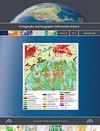地图标注语言对地图点符号视觉检索的影响
IF 2.4
3区 地球科学
Q1 GEOGRAPHY
Cartography and Geographic Information Science
Pub Date : 2021-12-16
DOI:10.1080/15230406.2021.2007419
引用次数: 4
摘要
摘要本研究旨在探讨地图标签语言对地图符号视觉搜索的影响。更具体地说,我们探讨了母语对目标点符号检测的视觉搜索地图任务性能的影响。主要的研究假设是,尽管标签语言影响反应时间,但目标符号的相对位置在视觉搜索过程中起着重要作用。在一项有38名参与者参与的受控实验室实验中,我们使用了用参与者的母语(波兰语)和中文标注的地图,参与者既不会读也不会写。我们发现,当中文标签的目标符号处于外围位置时,对目标符号的检测速度更快。另一方面,用被试的母语标记的目标符号的更快的检测倾向于中心位置。结果表明,在注意到目标符号后,参与者将注意力集中在母语标签上。对于中文标签,在看到目标符号后,参与者不会盯着标签看。结果还表明,当参与者搜索位于外围区域的目标符号时,该区域的视觉注意力更多。然而,当目标符号位于中心位置时,参与者的视觉注意力主要集中在中心区域。这证实了地图符号的位置在视觉搜索过程中的重要作用。本文章由计算机程序翻译,如有差异,请以英文原文为准。
The effect of map label language on the visual search of cartographic point symbols
ABSTRACT The present study aims to examine how the visual search for cartographic symbols is affected by the language of map labels. More specifically, we explore the influence of native language in the performance of a visual search map task which is referred to target point symbol detection. The main research hypothesis is that the relative position of the target symbols plays a significant role in the visual search process, although labels language impacts reaction time. In a controlled laboratory experiment with 38 participants and eye tracking technology, we used maps with labels in participants’ native language (Polish) and in Chinese, which participants could neither read nor write. We find that the detection of target symbols with Chinese labels is faster when the symbol’s location is peripheral. On the other hand, faster detection of target symbols with labels in participants’ native language favors central location. It turned out that having noticed the target symbol, participants fixated on the native language label. For Chinese labels, having seen the target symbol, participants did not fixate on the label. It also turned out that when participants searched for a target symbol located in the peripheral zone, more visual attention was in this zone. However, when the target symbol’s location was central, the participants’ visual attention focused mostly on the central zone. This confirms the significant role of the location of cartographic symbols in the visual search process.
求助全文
通过发布文献求助,成功后即可免费获取论文全文。
去求助
来源期刊
CiteScore
5.20
自引率
20.00%
发文量
23
期刊介绍:
Cartography and Geographic Information Science (CaGIS) is the official publication of the Cartography and Geographic Information Society (CaGIS), a member organization of the American Congress on Surveying and Mapping (ACSM). The Cartography and Geographic Information Society supports research, education, and practices that improve the understanding, creation, analysis, and use of maps and geographic information. The society serves as a forum for the exchange of original concepts, techniques, approaches, and experiences by those who design, implement, and use geospatial technologies through the publication of authoritative articles and international papers.

 求助内容:
求助内容: 应助结果提醒方式:
应助结果提醒方式:


